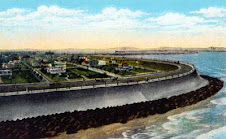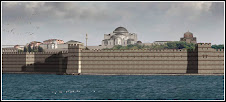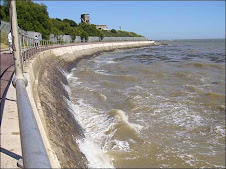They are built from a variety of materials, all of which must be proven to withstand pressure from both ocean waves, and settling land, since they serve as a barrier between these two opposing forces. To be most effective, a sea wall must be situated so that the land and surrounding infrastructure is raised above sea level, to account for large waves in the event of storms or strong currents.
2/27/08
What is a Sea Wall?
A sea wall is a man-made form of embankment along a coastal area meant to shield the land from the effects of large waves. These are usually built in areas in which there is a chance that local infrastructure, economy, or society could be damaged by rising sea levels or erosion.
They are built from a variety of materials, all of which must be proven to withstand pressure from both ocean waves, and settling land, since they serve as a barrier between these two opposing forces. To be most effective, a sea wall must be situated so that the land and surrounding infrastructure is raised above sea level, to account for large waves in the event of storms or strong currents.
They are built from a variety of materials, all of which must be proven to withstand pressure from both ocean waves, and settling land, since they serve as a barrier between these two opposing forces. To be most effective, a sea wall must be situated so that the land and surrounding infrastructure is raised above sea level, to account for large waves in the event of storms or strong currents.
Vertical Sea Walls
Curved Sea Walls
The main purpose of this kind of sea wall is to weaken waves before they reach the land. The gradual slope causes surges to shrink, and break before they get close enough to do any damage. Since they don’t actually absorb the impact of strong wave s, these are not as effective as their vertical counterparts. However, as they don’t obstruct the natural beauty of the sea as much, they are favored in areas in which the ocean is an important part of the local economy.
s, these are not as effective as their vertical counterparts. However, as they don’t obstruct the natural beauty of the sea as much, they are favored in areas in which the ocean is an important part of the local economy.
 s, these are not as effective as their vertical counterparts. However, as they don’t obstruct the natural beauty of the sea as much, they are favored in areas in which the ocean is an important part of the local economy.
s, these are not as effective as their vertical counterparts. However, as they don’t obstruct the natural beauty of the sea as much, they are favored in areas in which the ocean is an important part of the local economy.
Rubble Mounds and Sea Walls
Commonly known as “dunes,” these are heaps of rock and sand that serve the same function as a sea wall. They are more picturesque, but since they are also more prone to erosion and wear, they must be replenished often. Therefore, they are often more expensive and difficult to maintain than a sea wall.
sand that serve the same function as a sea wall. They are more picturesque, but since they are also more prone to erosion and wear, they must be replenished often. Therefore, they are often more expensive and difficult to maintain than a sea wall.
 sand that serve the same function as a sea wall. They are more picturesque, but since they are also more prone to erosion and wear, they must be replenished often. Therefore, they are often more expensive and difficult to maintain than a sea wall.
sand that serve the same function as a sea wall. They are more picturesque, but since they are also more prone to erosion and wear, they must be replenished often. Therefore, they are often more expensive and difficult to maintain than a sea wall.
Groynes and Sea Walls
These are either solid structures or piles of rubble that run perpendicular to the shore. Therefore, due to currents that run parallel to the beach, they b oth protect from incoming waves and prevent sand from being swept away. However, they are more visually obtrusive than sea walls, and are often seen as ugly. They also inhibit water recreation and damage natural habitats for marine life.
oth protect from incoming waves and prevent sand from being swept away. However, they are more visually obtrusive than sea walls, and are often seen as ugly. They also inhibit water recreation and damage natural habitats for marine life.
Vancouver Sea Wall
Pondicherry Sea Wall
This infamous sea wall lies on the eastern coast of India, surrounding the historic French colony of Pondicherry. In December of 2004, a huge tsunami hit this area, a nd it is due only to this three-century-old sea wall that the city was not destroyed. Since it was built, the government has routinely fortified the barrier with boulders - at some points, the wall reaches 27 feet above sea level. When the huge waves arrived in 2004, the maintenance paid off, since of the 600 deaths recorded, only a very few were people who lived in areas protected by the wall.
nd it is due only to this three-century-old sea wall that the city was not destroyed. Since it was built, the government has routinely fortified the barrier with boulders - at some points, the wall reaches 27 feet above sea level. When the huge waves arrived in 2004, the maintenance paid off, since of the 600 deaths recorded, only a very few were people who lived in areas protected by the wall.
 nd it is due only to this three-century-old sea wall that the city was not destroyed. Since it was built, the government has routinely fortified the barrier with boulders - at some points, the wall reaches 27 feet above sea level. When the huge waves arrived in 2004, the maintenance paid off, since of the 600 deaths recorded, only a very few were people who lived in areas protected by the wall.
nd it is due only to this three-century-old sea wall that the city was not destroyed. Since it was built, the government has routinely fortified the barrier with boulders - at some points, the wall reaches 27 feet above sea level. When the huge waves arrived in 2004, the maintenance paid off, since of the 600 deaths recorded, only a very few were people who lived in areas protected by the wall.
Subscribe to:
Comments (Atom)




